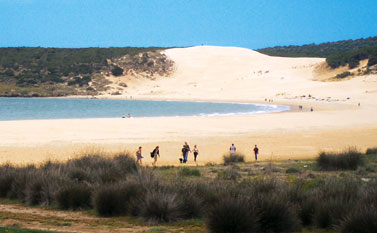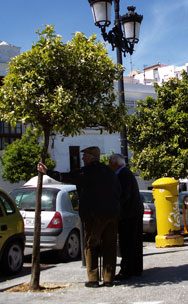- Villa search

- Canaries
- Caribbean
- Croatia, Bulgaria and Hungary
- Cyprus
- Florida
- France and Corsica
- Greece
- Italy
- Lakes and Mountains
- Madeira
- Malta and Gozo
- Portugal
- South Africa
- Spain - Balearics

Bolonia beach
Conil is an excellent base. Palm trees line the streets. People sit at pavement cafés and restaurants along the seafront drinking, eating, chatting. The Costa de la Luz is famed for its seafood – with an ocean view, we had a fantastic three-course meal of fried boquerones, seafood paella and ice cream for £13 each.
'It feels like you're in another era, not just a different country'
Conil is large enough – with plenty of shops, restaurants and bars open late – without being a bustling metropolis that saps your energy. The sun might do that, but in a nicer way – and then you just retreat to one of three beaches. La Fontanilla is best for swimming, but there are miles of open flat sands to wander. If you’re really feeling the heat, go back to your villa and chill out by the pool.
A short drive inland is Vejer de la Frontera, a majestic town 600ft above the Barbate River. It was once an important Moorish stronghold – the common prefix ‘de la Frontera’ refers to the mediaeval Arab-Christian frontier. A castle sits at its top, and clustered below are brilliant white buildings lining cobbled streets, all held within 15th century city walls. It feels like you’re in another era, not just a different country. The views are spectacular, showing off the region’s verdant countryside.
Medina Sidonia and Arcos de la Frontera are two other hilltop towns with Moorish histories and 360 degree views.

Orange trees provide welcome shade
Of the coast’s protected parks, the closest are Las Brenas and Marismas del Barbate – both full of walking trails. The former is a forest of pine wood running down to the coast at Canos de Meca, where its cliffs tower 330ft above sea level.
From Vejer you can also see the hills of the Alcornocales Natural Park, encompassing the largest – at 700 square miles – cork oak forest in Europe.
Within its boundaries you won’t find a single village, but there’s plenty of wildlife including deer, wild boar, wild goats, and Iberian Lynx. Look up and you may see Griffon vultures, Imperial eagles or Peregrine falcons – or walk up, and look down on them. A three to four-hour ascent takes you to the sandstone peak of El Picacho – you’ll be rewarded with a glimpse of Africa.
Tickets are needed at Doñana National Park, famous for the variety of its species of birds and – more unusually – its wild camels, the only ones in Europe. Imported from the Canary Islands in 1829 as an experiment in commercial transport, they were found to be useless for the purpose intended and set free.
home | destinations and editorial | villa search | property for sale | car hire | flights | services
villaseek blog | contact villaseek | links and resources | advertise your villa© Dune Root Ltd and Villaseek.com 2012 - Caribbean
- Canaries